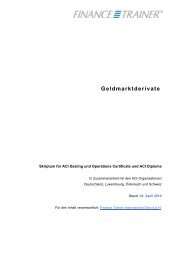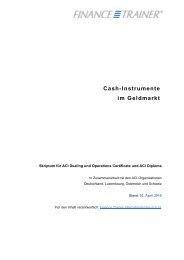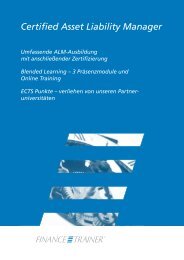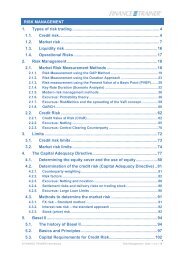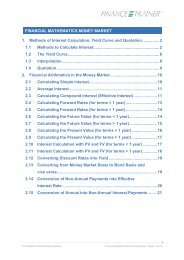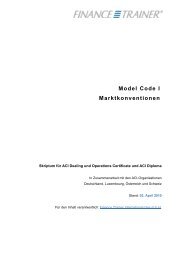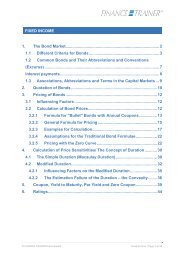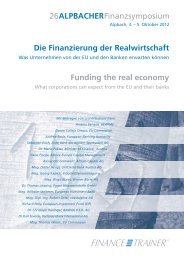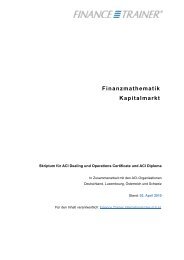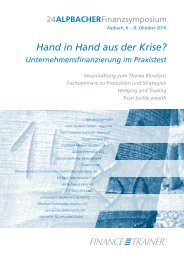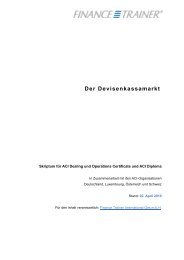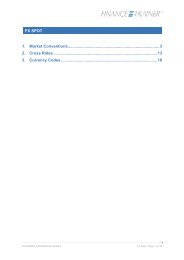1. Interest Rate Swap (IRS ... - Finance Trainer
1. Interest Rate Swap (IRS ... - Finance Trainer
1. Interest Rate Swap (IRS ... - Finance Trainer
You also want an ePaper? Increase the reach of your titles
YUMPU automatically turns print PDFs into web optimized ePapers that Google loves.
INTEREST RATE SWAP (<strong>IRS</strong>)<br />
<strong>1.</strong> <strong>Interest</strong> <strong>Rate</strong> <strong>Swap</strong> (<strong>IRS</strong>) .......................................................................... 4<br />
<strong>1.</strong>1 Terminology........................................................................................ 4<br />
<strong>1.</strong>2 Application........................................................................................ 11<br />
<strong>1.</strong>3 EONIA <strong>Swap</strong>...................................................................................... 19<br />
<strong>1.</strong>4 Pricing and Mark to Market Revaluation of <strong>IRS</strong> ............................ 22<br />
2. Cross Currency <strong>Swap</strong>............................................................................. 24<br />
2.1 Terminology...................................................................................... 24<br />
2.2 Application........................................................................................ 27<br />
3. Development of Financial <strong>Swap</strong>s.......................................................... 29<br />
4. Closing a <strong>Swap</strong> Position ........................................................................ 31<br />
© FINANCE TRAINER International <strong>Interest</strong> <strong>Rate</strong> <strong>Swap</strong> (<strong>IRS</strong>) / Page 1 of 31
INTEREST RATE SWAP (<strong>IRS</strong>)<br />
Since the early 80s, the term "swap" is used not only for a special type of forward exchange<br />
deal but also for a series of other financial instruments: the interest rate swaps (<strong>IRS</strong>). In the<br />
meantime, <strong>IRS</strong> (often simply referred to as "swaps") have become one of the most important<br />
financial instruments in the financial market.<br />
We differentiate between the following types of financial swaps:<br />
interest rate swaps<br />
currency swaps, cross currency swaps<br />
credit swaps and swaps of the second and third generation (which will not be discussed<br />
here)<br />
The possible roles of banks in the swap business are explained in the following:<br />
Public agent<br />
The bank brokers a swap deal between two potential parties and supports them with its<br />
know-how during the negotiations of the contract. Legally, the bank is not involved in the<br />
contract and therefore does not take on any risk.<br />
Anonymous agent<br />
The bank takes the role of an intermediary between two parties ("A" and "C"). With both<br />
parties, the bank concludes a contract separately. Parties "A" and "C" do not enter a legal<br />
agreement. In this case, the risks of creditworthiness are taken over by the bank.<br />
Active party<br />
The swap is taken as an active position by the bank on its own risk, i.e. the bank takes on the<br />
credit risk as well as the market risk.<br />
Counterparties<br />
The two parties to a swap deal.<br />
© FINANCE TRAINER International <strong>Interest</strong> <strong>Rate</strong> <strong>Swap</strong> (<strong>IRS</strong>) / Page 2 of 31
Fixed-rate payer<br />
The fixed-rate payer of a swap is the party that pays a fix interest-rate. The fixed-rate payer<br />
is also called swap "buyer". The recipient of the fixed-rate interest is called fixed-rate receiver<br />
or swap "seller".<br />
Floating-rate payer<br />
The floating-rate payer of a swap is the party that pays a floating interest rate.<br />
Principal<br />
The principal is the amount of capital that is the basis for the calculation of the interest<br />
payments in a swap (usual principals lie between 10 and 100 Mio per deal; other amounts<br />
are possible, too).<br />
Trading date<br />
On the trading date, the two parties agree to make a swap deal.<br />
Settlement date / effective date<br />
On settlement date, the calculation of interest payments from the swap starts. Regarding the<br />
settlement date one differentiates between two types of swaps:<br />
Spot swaps: settlement date is usually two days after the trading date (exception is e.g.<br />
GBP: same-day settling)<br />
Forward swaps: settlement date is on a different date than the two days after trading<br />
date (exceptions: see above).<br />
Maturity date<br />
Maturity of a swap is the last day of its term.<br />
© FINANCE TRAINER International <strong>Interest</strong> <strong>Rate</strong> <strong>Swap</strong> (<strong>IRS</strong>) / Page 3 of 31
<strong>1.</strong> <strong>Interest</strong> <strong>Rate</strong> <strong>Swap</strong> (<strong>IRS</strong>)<br />
An interest rate swap is a contract between two parties ("A" and "B") to exchange different,<br />
specified interest payments in the same currency during a term that is stated in the contract.<br />
The amount of the interest payment is calculated on the underlying principal and the interest<br />
rate of the respective interest period. The principal is not exchanged under an interest rate<br />
swap.<br />
<strong>1.</strong>1 Terminology<br />
<strong>Swap</strong>s can be differentiated with regard the types of interest payment<br />
<br />
Coupon swap (also called fixed-rate interest swap)<br />
Exchange of a fixed against a floating interest rate<br />
A<br />
fixed rate<br />
payer<br />
fixed rate<br />
floating rate<br />
B<br />
fixed rate<br />
receiver<br />
<br />
Basis swap<br />
Exchange of two different, floating interest rates in the same currency.<br />
A<br />
fixed rate X<br />
payer<br />
floating rate X<br />
floating rate Y<br />
B<br />
fixed rate Y<br />
payer<br />
© FINANCE TRAINER International <strong>Interest</strong> <strong>Rate</strong> <strong>Swap</strong> (<strong>IRS</strong>) / Page 4 of 31
Cross Currency <strong>Interest</strong> <strong>Rate</strong> <strong>Swap</strong><br />
Exchange of two interest rates in different currencies<br />
Currency A<br />
payer<br />
interest rate currency A<br />
interest rate currency B<br />
Currency B<br />
payer<br />
Coupon swap<br />
A coupon swap (also called fixed-rate interest swap, par swap, or plain vanilla swap) is a<br />
contract between two parties ("A" and "B") to exchange a fixed-rate interest payment for a<br />
floating-rate interest payment. It is calculated on the basis of a fixed principal for an agreed<br />
period of time.<br />
Conventions<br />
We want to demonstrate the chronological steps of a spot swap with an example: A CHF<br />
fixed-rate interest swap with a term of 5 years and annual fixed-rate interest payments<br />
against 6-months CHF LIBOR.<br />
Trading date: September 1 st, 2009<br />
Principal: CHF 100,000,000<br />
Deal:<br />
5 years fixed, 5.20 % annually<br />
First LIBOR, fixed: 3.50 %<br />
© FINANCE TRAINER International <strong>Interest</strong> <strong>Rate</strong> <strong>Swap</strong> (<strong>IRS</strong>) / Page 5 of 31
LIBOR fixing<br />
Beginning of the<br />
End of the interest<br />
<strong>Interest</strong> payments<br />
interest period<br />
period<br />
floating<br />
fixed<br />
September 1 st , 2009 September 3 rd , 2009 March 3 rd , 2010 3.50% -<br />
February 27 th , 2010 March 3 rd , 2010 September 3 rd , 2010 LIBOR 5.20 %<br />
September 1 st , 2010 September 3 rd , 2010 March 3 rd , 2011 LIBOR -<br />
March 1 st , 2011 March 3 rd , 2011 September 5 th , 2011 LIBOR 5.20 %<br />
September 1 st , 2011 September 5 th , 2011 March 5 th , 2012 LIBOR -<br />
March 1 st , 2012 March 5 th , 2012 September 3 rd , 2012 LIBOR 5.20 %<br />
August 30 th , 2012 September 3 rd , 2012 March 4 th , 2013 LIBOR -<br />
February 28 th , 2013 March 4 th , 2013 September 3 rd , 2013 LIBOR 5.20 %<br />
August 30 th , 2013 September 3 rd , 2013 March 3 rd , 2014 LIBOR -<br />
February 27 th , 2014 March 3 rd , 2014 September 3 rd , 2014 LIBOR 5.20 %<br />
Quotation<br />
Fixed-rate interest swaps are usually quoted as a fixed interest rate for the term on the basis<br />
of the reference rate (e.g. LIBOR) without spread, i.e. flat.<br />
In the example above, the quotation of the 5-year CHF swap against the 6-months CHF<br />
LIBOR would be 5.20 %.<br />
The quotation on the fixed-rate side can be done by a quotation of the interest rate (e.g. 5.20<br />
%) or by a quotation of the spread to the current yield of (usually) government bonds (usually<br />
for USD).<br />
© FINANCE TRAINER International <strong>Interest</strong> <strong>Rate</strong> <strong>Swap</strong> (<strong>IRS</strong>) / Page 6 of 31
A market maker's quotation for a 5-year USD fixed-rate swap against<br />
3-months USD LIBOR would be:<br />
5.00 % – 5.05 %<br />
The market maker is willing to pay a fixed interest rate of 5.00 % for<br />
the swap. As fixed-rate receiver, he demands 5.05 % from the<br />
counterparty.<br />
The market maker's quotation could also be the following:<br />
5-years T bond + 20 / 25<br />
In this case, the current yield of 5-year T-bonds had to be fixed first<br />
and then the quoted spread of 20 and 25 basis points is added. If we<br />
assume a current 5-year yield of 4.80 % the following rates would be<br />
effective<br />
5.00 % – 5.05 %<br />
(4.80 % + 20 bp) (4.80 % + 25 bp)<br />
I. Floating-rate interest payments<br />
Floating index<br />
Usually the money market reference rate (LIBOR, EURIBOR, TIBOR), often a 3-months or 6-<br />
months index, but also individual solutions for each swap, i.e. 1-months, 12-months or other<br />
indices are also possible.<br />
Reset date / fixing date<br />
On fixing date, the interest rate is adjusted, i.e. the interest rate for the following interest<br />
period is fixed. Usually, the fixing of swap rates takes place 2 working days before the<br />
interest period starts (exceptions: GBP same-day fixing); but it is also possible to fix the swap<br />
rate during the term which is then valid for the running term (in arrears).<br />
© FINANCE TRAINER International <strong>Interest</strong> <strong>Rate</strong> <strong>Swap</strong> (<strong>IRS</strong>) / Page 7 of 31
<strong>Interest</strong> period<br />
The length of an interest period normally equals the floating rate index, i.e. with a swap<br />
against a 3-months LIBOR the floating interest period is 3 months (but also concerning the<br />
structuring of interest periods, swaps are usually quite flexible).<br />
Frequency of payments<br />
Usually, payments are due at the end of each interest period. (Exception: EONIA <strong>Swap</strong>).<br />
Calculation of interest payments<br />
Usually, the interest payments are calculated according to the currencies’ money market<br />
conventions.<br />
II. Fixed-rate interest payments<br />
Fixed interest rate<br />
The interest rate, agreed on the trading date, holds for the whole term of the swap.<br />
Adjustment of interest rate<br />
The interest rate is not adjusted.<br />
Frequency of payments<br />
The frequency of interest payments can be freely arranged (monthly, quarterly, six-monthly,<br />
annually, etc.). With EUR and CHF, annual payments are usual, with USD/GBP/JPY semiannual<br />
payments are quite common.<br />
Calculation of interest payments<br />
The calculation of interest payments is analogously to the practice on the respective capital<br />
markets.<br />
© FINANCE TRAINER International <strong>Interest</strong> <strong>Rate</strong> <strong>Swap</strong> (<strong>IRS</strong>) / Page 8 of 31
Netting<br />
If, in a swap, interest payments between the counterparties flow on the same dates, only the<br />
difference between the interest payments, i.e. the net amount, is exchanged.<br />
A<br />
fixed rate<br />
payer<br />
fixed rate<br />
floating rate<br />
B<br />
fixed rate<br />
receiver<br />
Trading date: September 2 nd , 2009<br />
Principal: USD 100,000,000<br />
Deal:<br />
5 years fixed, 5.20 % annually<br />
First LIBOR, fixed: 3.50 %<br />
LIBOR fixing<br />
Beginning of the<br />
End of the interest<br />
<strong>Interest</strong> payments<br />
interest period<br />
period<br />
floating<br />
fixed<br />
September 2 nd , 2009 September 4 th , 2009 March 4 th , 2010 3.50%<br />
March 2 nd , 2010 March 4 th , 2010 September 6 th , 2010 LIBOR 5.20 %<br />
September 2 nd , 2010 September 6 th , 2010 March 4 th , 2011 LIBOR -<br />
• • • • •<br />
• • • • •<br />
• • • • •<br />
February 28 th , 2014 March 4 th , 2014 September 4 th , 2014 LIBOR 5.20 %<br />
on March 4 th , 2010 I) B pays A 3.5 % for the first 6 months<br />
on September 6 th , 2010 I) B pays A LIBOR for the second 6 months<br />
on September 6 th , 2010 II) A pays B 5.2 % for the first year<br />
© FINANCE TRAINER International <strong>Interest</strong> <strong>Rate</strong> <strong>Swap</strong> (<strong>IRS</strong>) / Page 9 of 31
Cash flow on September, 6 th 2010:<br />
I) – II) = net cash flow<br />
if I) < II) A pays the difference to B<br />
if I) > II) B pays the difference to A<br />
Asset swap and liability swap<br />
The terms "asset swap" and "liability swap" are used according to the side of the balance<br />
sheet that is changed by the swap transaction:<br />
From the investor’s point of view, an asset swap is the swapping of a<br />
<br />
<br />
fixed interest rate investment into a floating rate investment (= fixed-rate payer swap)<br />
floating interest rate into a fixed rate investment (= fixed-rate receiver swap).<br />
A liability swap deals with the re-financing side of the balance. It is a swap that turns a<br />
<br />
<br />
fixed into a floating refinancing (= fixed-rate receiver swap)<br />
floating into a fixed refinancing (= fixed-rate payer swap).<br />
© FINANCE TRAINER International <strong>Interest</strong> <strong>Rate</strong> <strong>Swap</strong> (<strong>IRS</strong>) / Page 10 of 31
<strong>1.</strong>2 Application<br />
<strong>Swap</strong> from floating into fixed refinancing<br />
Bank X has a floating refinancing in the market with the following<br />
conditions:<br />
7 years at 6-months LIBOR + 0.25 %<br />
The bank expects interest rates to rise in 2 years. It decides to swaps<br />
the floating rate into a fixed rate. This can be done by re-paying the<br />
current liabilities and simultaneously borrowing money at a fixed<br />
interest rate. A pre-mature repayment is not possible or would be<br />
unprofitable for the bank because of the high additional costs for the<br />
contract termination.<br />
Therefore, X completes a fixed-rate interest rate swap for the rest of<br />
the term (5 years) at market conditions:<br />
5-years at 5.20 % for the 6-months LIBOR<br />
(From X's point of view, this deal is a liability swap.)<br />
X<br />
fixed rate<br />
payer<br />
5.20 %<br />
6-months LIBOR<br />
swap patner<br />
fixed rate<br />
receiver<br />
6-months LIBOR + 0.25 %<br />
floating<br />
refinancing<br />
© FINANCE TRAINER International <strong>Interest</strong> <strong>Rate</strong> <strong>Swap</strong> (<strong>IRS</strong>) / Page 11 of 31
Under the interest rate swap, the 6-months LIBOR is just like a running position:<br />
<br />
<br />
X pays 6-months LIBOR + 0.25 % for the floating refinancing.<br />
X receives 6-months LIBOR from the interest rate swap.<br />
For X, the net interest payment from the two floating interest rates (0.25 %) remains. The<br />
fixed interest rate from the swap has to be added.<br />
Ignoring the effects of compound interest (annual fixed interest rate in contrast to a 6-months<br />
LIBOR) and the different basis of interest (30 / 360 compared to ACT / 360), the effective<br />
costs are:<br />
X pays 0.25 %<br />
X pays 5.20 %<br />
X pays 5.45 %<br />
<strong>Swap</strong> from fixed to floating refinancing<br />
Bank X issued a fixed-rate interest bond 2 years ago:<br />
fixed interest rate is 4.75 %, total term 7 years<br />
The bank decides to change the fixed-rate interest payment into a<br />
floating one, according to its expectations on the further development<br />
of interest rates.<br />
This could be done by an additional floating refinancing and a fixedrate<br />
interest investment. But this would lead to an unwanted<br />
extension of the balance sheet. Also, the costs of the spread between<br />
investment and refinancing must be taken into account. Because X<br />
wants to avoid these effects, the bank will use an interest rate swap<br />
(fixed-rate receiver swap).<br />
© FINANCE TRAINER International <strong>Interest</strong> <strong>Rate</strong> <strong>Swap</strong> (<strong>IRS</strong>) / Page 12 of 31
Market conditions:<br />
5-years at 5.20 % for a 6-months LIBOR<br />
(From X's point of view, this is a liability swap, because the swap will<br />
leads to a change on the liability side of the balance.)<br />
X<br />
fixed rate<br />
receiver<br />
6-months LIBOR<br />
5.20 %<br />
swap patner<br />
fixed rate<br />
payer<br />
4.75 %<br />
fixed rate<br />
interest bond<br />
X could turn the fixed interest payments into floating ones by<br />
completing the swap.<br />
The following are the effective interest costs for X:<br />
X pays 4.75 % for the fixed-rate interest bond<br />
X receives 5.20 % from the interest rate swap<br />
X receives 0.45 %<br />
X pays 6-months LIBOR for the interest rate swap.<br />
Often, the difference between the interest rates (here: 0.45 %) is<br />
defined as the LIBOR spread. Ignoring compound interest and<br />
different basis of interest rates, X pays 6-months LIBOR – 0.45 %.<br />
In this example, the change in the market interest rates leads to 6-<br />
months LIBOR – 0.45 %. In other cases, the cost of refinancing<br />
("LIBOR – x") can be achieved by exploiting the of advantages of<br />
capital markets through swaps (see point 5).<br />
© FINANCE TRAINER International <strong>Interest</strong> <strong>Rate</strong> <strong>Swap</strong> (<strong>IRS</strong>) / Page 13 of 31
<strong>Swap</strong> from floating into fixed investment (loan)<br />
Bank X gives a rollover credit (6-months LIBOR + 1 %, 7-year term)<br />
to a company. At the same time, the bank has the possibility to issue<br />
a fixed-rate interest bond at 5.50 % and a term of 7 years.<br />
X wants to use the issue's liquidity for the credit but does not want to<br />
take on any interest rate risks. This cannot be achieved with the<br />
classic instruments of the balance sheet. By completing a fixed-rate<br />
receiver swap, X can use the issue's liquidity for the credit while<br />
simultaneously eliminating the interest rate risk.<br />
In this case, a clear line between an asset swap and a liability swap<br />
cannot be drawn. In combination with the rollover credit the deal is an<br />
asset swap while in conjunction with the issue the same swap is a<br />
liability swap.<br />
X completes an interest rate swap:<br />
5.55 % for 6-months LIBOR, 7-year term<br />
roll-over<br />
credit<br />
6-months LIBOR + <strong>1.</strong>0%<br />
X<br />
fixed rate<br />
receiver<br />
6-months LIBOR<br />
5.55 %<br />
swap patner<br />
fixed rate<br />
payer<br />
5.50 %<br />
fixed rate<br />
interest bond<br />
© FINANCE TRAINER International <strong>Interest</strong> <strong>Rate</strong> <strong>Swap</strong> (<strong>IRS</strong>) / Page 14 of 31
Because X pays and receives interest payments on both the floating<br />
and fixed side, it has virtually eliminated the interest rate risk.<br />
The net interest income of the whole deal is:<br />
+ (6-months LIBOR + 1 %) – (6-months LIBOR) = <strong>1.</strong>00 %<br />
– (5.50 %) + (5.55 %) = 0.05 %<br />
= <strong>1.</strong>05 % *)<br />
*) (Ignoring arrangements for payments of fixed and floating rates of interest.)<br />
<strong>Swap</strong> from fixed into floating investment<br />
In times of high interest rates, X had completed a fixed-rate interest<br />
bond: 7.0 % fixed-rate interest bond, time to maturity: 5 years.<br />
The bank assumes that the interest rates have already passed the<br />
trough and are going to rise again. The sale of the bond may not be<br />
possible for several reasons:<br />
The bond is part of the fixed assets and therefore cannot be sold.<br />
The market for this bond is not very liquid and the selling price is<br />
not attractive.<br />
The liquidity that results from the sale of the bond must be<br />
invested, and possible spreads and / or equity costs may occur.<br />
© FINANCE TRAINER International <strong>Interest</strong> <strong>Rate</strong> <strong>Swap</strong> (<strong>IRS</strong>) / Page 15 of 31
X decides to go in for an asset swap: in this case a fixed-rate payer<br />
swap<br />
5.20 % for 6-months LIBOR, 5-year term<br />
X<br />
fixed rate<br />
payer<br />
5.20 %<br />
6-months LIBOR<br />
swap patner<br />
fixed rate<br />
receiver<br />
7.00 %<br />
bond<br />
By completing the swap, X can realise a net interest income of <strong>1.</strong>80<br />
% until maturity (assuming that the bank refinances at LIBOR + / –<br />
0.0 %, i.e. LIBOR flat, for the whole term of the swap).<br />
Note: The term "coupon" swap for a fixed-rate interest swap may<br />
result from the above application: The earnings of the coupons go<br />
(partly) into the interest rate swap.<br />
Arbitrage on credits with interest rate swaps<br />
<strong>Interest</strong> rate swaps are often used to exploit the so-called comparative advantage. This term<br />
was coined by David Ricardo, who in the 19 th century developed the theory of comparative<br />
advantage for the international exchange of goods. Applied to the financial market, the theory<br />
says that the exchange of different interest rates can be profitable for both parties if they<br />
encounter different conditions on the different markets. This is even true, if one of the parties<br />
has better conditions on both markets, i.e. has a lower fixed and floating interest rate.<br />
© FINANCE TRAINER International <strong>Interest</strong> <strong>Rate</strong> <strong>Swap</strong> (<strong>IRS</strong>) / Page 16 of 31
Assume, that company X has an AAA rating company Y has an A-<br />
rating. Company X needs a variable refinancing for 5 years and<br />
company Y needs a fixed refinancing for 5 years.<br />
company X<br />
company Y<br />
fixed interest rate 5.50 % 6.25 %<br />
floating interest rate LIBOR LIBOR + 25 bp<br />
If both companies refinance themselves according to their demand,<br />
the costs would be for:<br />
Company X floating at LIBOR and for<br />
Company Y fixed at 6.25 %.<br />
Alternatively, both companies may choose the opposite refinancing;<br />
i.e. company X refinances itself at a fixed rate of 5.50 % while<br />
company Y chooses a floating rate of LIBOR + 25 bp.<br />
Simultaneously, they arrange an interest rate swap by which<br />
company X gets a fixed rate and pays LIBOR (vice versa for company<br />
Y).<br />
Assuming a fixed interest rate of 5.75 %, the deal can be shown as<br />
this:<br />
LIBOR<br />
X<br />
Y<br />
5,75 % fixed<br />
5,50 % fixed<br />
(refinancing)<br />
LIBOR +<br />
0.25%<br />
© FINANCE TRAINER International <strong>Interest</strong> <strong>Rate</strong> <strong>Swap</strong> (<strong>IRS</strong>) / Page 17 of 31
Result<br />
From X's point of view:<br />
X pays a fixed rate of 5.50 % for its refinancing and receives a fixed rate of 5.75 % from the<br />
swap: the profit on the fixed rate side is 0.25 %. Since X has to pay LIBOR, the total cost is<br />
LIBOR – 25 bp. This calculation takes the profit from the fixed side into account.<br />
From Y's point of view:<br />
Y pays a floating rate of LIBOR + 25 bp for its refinancing and receives a floating rate of<br />
LIBOR from the swap: the loss on the floating side 25 bp. Since Y faces a fixed interest rate<br />
payment of 5.75 %, it has locked in a fixed rate of 6.00 % (5.75% from the swap + 25 bp loss<br />
on the floating interest rate). Company Y could also reduce its refinancing costs by 25 bp<br />
(6.25 % to 6.00 %).<br />
The total benefit from the interest rate swap is 0.50 % and is a result of the different market<br />
conditions for the companies in the markets. In the market for floating rates, the difference<br />
between the conditions is 0.25 % (X: LIBOR; Y: LIBOR + 0.25 %), in the market for fixed<br />
rates the difference is 0.75 % (X: 5.50 %; Y: 6.25 %). The total difference of 0.50 % (0.75 %<br />
– 0.25 %) is the comparative advantage that is realised in the swap deal.<br />
Note: In order to speak of a real arbitrage, one had to compare interest rates in the capital<br />
market, i.e. the conditions for both contractors over the whole term, for fixed- and floatingrates.<br />
In practice, the possible interbank refinancing in the money market is often used as the<br />
basis for the floating interest rates.<br />
In the situation above, this would mean from Y's point of view that the company has access<br />
to an interbank refinancing at LIBOR + 25 bp for the whole term. If the spread changes<br />
during the term, the basis for the calculation also changes.<br />
© FINANCE TRAINER International <strong>Interest</strong> <strong>Rate</strong> <strong>Swap</strong> (<strong>IRS</strong>) / Page 18 of 31
<strong>1.</strong>3 EONIA <strong>Swap</strong><br />
Like the classic swaps in the capital market, the EONIA swap (Euro Overnight Index Average<br />
<strong>Swap</strong>) was developed in Germany (as FIONA SWAP) to serve as part of the risk<br />
management in the money market.<br />
Similar swaps already exist in other countries, USA (Fed funds swap). Especially for shortterm<br />
interest rates, there was still a derivative missing with which interest rate risks could be<br />
reduced and the flexibility increased. This swap helps to vary the locked-in of interest rates<br />
on a short-term basis and to reduce the risk of varying overnight rates.<br />
Principle<br />
Just as with swaps in the capital market, a fixed interest rate is swapped against a floating<br />
interest rate; where one of the rates is paid and the other one is received. At the trading date,<br />
the fixed interest rate, the principal, and the length of the term are determined. The floating<br />
interest rate is calculated on the basis of the overnight rates that are determined by the<br />
EURIBOR fixing during the EONIA term. On the maturity date, a settlement payment is due,<br />
which is calculated by comparing the floating rate to the fixed rate in relation to the term and<br />
principal. However, the calculation of the floating interest rate of EONIA swaps is more<br />
complicated in comparison to the calculation in the capital market. It is not simply calculated<br />
as an average of the overnight rates but also takes into account the effects of compound<br />
interest. This effect is demonstrated in the following example:<br />
© FINANCE TRAINER International <strong>Interest</strong> <strong>Rate</strong> <strong>Swap</strong> (<strong>IRS</strong>) / Page 19 of 31
Formula to calculate the floating rate<br />
⎪⎧<br />
⎡ d e<br />
r= ⎨⎢∏ −<br />
i=<br />
d1<br />
⎪⎩ ⎢⎣<br />
1<br />
⎛ ri⋅D<br />
i<br />
⎜<br />
1+<br />
⎝ 360<br />
⎞⎤<br />
⎪⎫<br />
360<br />
⎟<br />
⎥−1⎬⋅<br />
⎠⎥⎦<br />
⎪⎭<br />
D<br />
r = floating rate including effects of compound interest<br />
d 1<br />
d e<br />
= start date of the EONIA swap<br />
= maturity date<br />
r i = rate of overnight fixing (in per cent, divided by 100)<br />
D i<br />
D<br />
= number of days for which ri is valid (usually 1 day, weekends: 3 days)<br />
= days of EONIA swap's term<br />
Two parties (A and B) complete a swap with an underlying of EUR<br />
250 Mio:<br />
”A” is receiver of the fixed-rate of 3.20 % for a term of 7 days (April 9 th<br />
- 13 th , 2009)<br />
Assume the following overnight rates:<br />
April 6 th 3.125 % (1 day)<br />
April 7 th 3.100 % (1 day)<br />
April 8 th 3.150 % (1 day)<br />
April 9 th 3.150 % (1 day)<br />
April 10 th 3.125 % (3 days)<br />
Using the formula, we get<br />
⎧ ⎡⎛ 0,03125 ⎞ ⎛ 0,031 ⎞ ⎛ 0,0315 ⎞ ⎛ 0,0315 ⎞ ⎛ 0,03125 ⋅3<br />
⎞ ⎤ ⎫ 360<br />
⎨ ⎢⎜<br />
1 + ⎟ ⋅ ⎜ 1 + ⎟ ⋅ ⎜ 1 + ⎟ ⋅ ⎜ 1 + ⎟⋅ ⎜ 1+<br />
⎟ −1⎬<br />
⋅<br />
⎩ 360 360 360 360<br />
360<br />
⎥<br />
⎣⎝<br />
⎠ ⎝ ⎠ ⎝<br />
⎠ ⎝<br />
⎠ ⎝<br />
⎠ ⎦ ⎭ 7<br />
= 3.12927 %<br />
(Comparison: the arithmetic average = 3.12857)<br />
© FINANCE TRAINER International <strong>Interest</strong> <strong>Rate</strong> <strong>Swap</strong> (<strong>IRS</strong>) / Page 20 of 31
Party A gets 3.20 % for 7 days on EUR 250 Mio, i.e. EUR<br />
155,555.56. At the same time, A pays 3.12927 % for the same<br />
principal and the same term, i.e. EUR 152,117.29.<br />
This means, A receives a settlement payment of EUR 3,438.22 from<br />
B, because only the difference between the two payments is<br />
exchanged (netting).<br />
Company C has an overnight deposit at bank A of EUR 500 Mio at an<br />
interest rate that is pegged to the overnight rate (fixing rate is 0.10<br />
%). The customer deposit will last for one week. The bank, expecting<br />
rising overnight rates, enters an EONIA swap of EUR 500 Mio in<br />
which it pays 3.15 % for a week and receives the average overnight<br />
rate.<br />
bank A<br />
fixed rate<br />
payer<br />
3.15 %<br />
EONIA overnight rate<br />
swap patner<br />
EUR 500 Mio<br />
deposit<br />
EONIA overnight rate – 0.10<br />
company C<br />
With the swap, bank A has hedged itself against paying higher<br />
overnight rates for the customer's deposit in the future. Now it has the<br />
deposit in its trading book at 3.05 %.<br />
Since the bank receives the average overnight rate and pays 10 basis<br />
points below EONIA overnight rate, the interest rate is lower than the<br />
swap.<br />
Furthermore, bank A must decide what to do with the money. The<br />
alternatives are: a loan in the overnight market at the expected higher<br />
interest rates or a loan for a week.<br />
© FINANCE TRAINER International <strong>Interest</strong> <strong>Rate</strong> <strong>Swap</strong> (<strong>IRS</strong>) / Page 21 of 31
Specifications of the contract<br />
<br />
<br />
<br />
<br />
<br />
Money market swap with free setting of terms (2 days to 12 months)<br />
Start date usually two working days after trade date<br />
Date of payment is at maturity, but only the settlement payment is exchanged<br />
Overnight rate is determined by the EURIBOR fixing (telerate 22000), compound<br />
interest is included and the euro method (ACT / 360) is used.<br />
Documentation is done according to ISDA treaty or German framework treaty.<br />
<strong>1.</strong>4 Pricing and Mark to Market Revaluation of <strong>IRS</strong><br />
As shown in the example of comparative advantage, a swap deal can be of advantage for<br />
both counterparties. You assume that the price was "fair" when the deal was settled.<br />
But when can one speak of a "fair" price<br />
Assumption:<br />
The market quote for a 5-year swap against 6-months LIBOR is<br />
5.18 – 5.22 % p.a.<br />
Therefore a swap settled at 5.20 % is fair. Neither party A nor B is in a better situation than<br />
its partner at the trading date. This means, that the present value of the swap is 0.<br />
If the market price for a 5-year swap changes during the day due to changes in supply and<br />
demand, to 5.23 – 5.27 % p.a., the present value of a settled swap also changes.<br />
To evaluate swaps at market interest rates (a "mark to market" evaluation) the variable cashflows<br />
(floating rate payments) have to be compared to the fixed rate payments.<br />
In order to make cash flows of different times comparable, the present values of the cash<br />
flows are calculated (with zero rates).<br />
© FINANCE TRAINER International <strong>Interest</strong> <strong>Rate</strong> <strong>Swap</strong> (<strong>IRS</strong>) / Page 22 of 31
Bank A has entered into a fixed rate receiver swap with Bank B, for<br />
EUR 100 m for 5 years. It receives 4,75% p.a. against 6-months<br />
EURIBOR. After3 years Bank A wants to close the position and<br />
receives the following EUR <strong>IRS</strong> quotation from Bank C: 2-years <strong>IRS</strong><br />
against 6-months EURIBOR 4.31 – 4.35%. The zero rates for 1 year<br />
are 4.50% and for 2 years 4.55%.<br />
What is the MtM-value of the swap position<br />
The position of Bank A looks as follows:<br />
4.35%<br />
4.75%<br />
BANK C BANK A BANK B<br />
6m EURIBOR<br />
6m EURIBOR<br />
Bank A closes the original swap deal by buying the 2-years <strong>IRS</strong> from<br />
Bank C (= fixed rate payer swap). It pays 4.35% and receives 6-<br />
months EURIBOR. As the variable interest payments run through,<br />
only the 2 fixed rate payments have to be considered for the<br />
calculation of the MtM value.<br />
Calculation of the result:<br />
Year<br />
Original<br />
Opposite<br />
Result<br />
Discount<br />
Present<br />
swap deal<br />
deal<br />
(1/(1+r) n )<br />
Value<br />
1 +4,750,000 -4,350,000 +400,000 0.9569378 +382,775<br />
2 +4,750,000 -4,350,000 +400,000 0.9148543 +365,942<br />
Total +748,717<br />
The actual value of the 5-years EUR <strong>IRS</strong> is EUR 748,717 (= Mark to Market result).<br />
© FINANCE TRAINER International <strong>Interest</strong> <strong>Rate</strong> <strong>Swap</strong> (<strong>IRS</strong>) / Page 23 of 31
2. Cross Currency <strong>Swap</strong><br />
2.1 Terminology<br />
A currency swap (or cross-currency swap) is a contract between two parties (A and B) to<br />
exchange two different, specific interest payments in different currencies (1 and 2) during a<br />
term that is fixed in the contract. The interest payments are calculated on the basis of the<br />
principals of the two currencies and the interest rate for the respective term of interest.<br />
Under a currency swap, the principal is usually exchanged. For all the transactions an<br />
exchange rate is fixed for all transactions when the swap is entered<br />
Basically, one can divide a currency swap into three different transactions.<br />
Initial transaction: Exchange of the principal in different<br />
currencies 1 and 2 (initial exchange)<br />
<strong>Interest</strong> payment Exchange of interest payments in different currencies during the<br />
swap term<br />
Final transaction: Re-exchange of the principal in 1 and 2 (final exchange)<br />
principal currency 1<br />
principal currency 2<br />
initial exchange<br />
interest currency 2<br />
interest currency 1<br />
final exchange<br />
principal currency 2<br />
principal currency 1<br />
© FINANCE TRAINER International <strong>Interest</strong> <strong>Rate</strong> <strong>Swap</strong> (<strong>IRS</strong>) / Page 24 of 31
Cross currency swaps are closely related to FX swaps where only the principals are<br />
exchanged and no interest payments are made in the two currencies.<br />
The term of a currency swap is usually longer than 1 year.<br />
Depending on the stipulated rate for the final exchange, one differentiates between "forward<br />
outright" and "par value” swap:<br />
Forward outright:<br />
At a forward outright cross currency swap, a forward exchange rate, prevailing at the trading<br />
date, for the final exchange is fixed<br />
Par value:<br />
At a par value cross currency swap, the exchange rate for the initial exchange is the same as<br />
the exchange rate for the final exchange (one usually fixes the par value rate at the mid spot<br />
rate)<br />
Note: As an exceptional case, the initial or final exchange (or both) may not take place at all.<br />
For cross currency swaps, like for interest rate swaps, exist several combinations concerning<br />
the exchange of interest payments.<br />
Fixed against fixed<br />
principal currency 1<br />
principal currency 2<br />
initial exchange<br />
interest currency 2<br />
interest currency 1<br />
final exchange<br />
principal currency 2<br />
principal currency 1<br />
© FINANCE TRAINER International <strong>Interest</strong> <strong>Rate</strong> <strong>Swap</strong> (<strong>IRS</strong>) / Page 25 of 31
Fixed against floating<br />
principal currency 1<br />
principal currency 2<br />
fixed interest currency 2<br />
fixed interest currency 1<br />
principal currency 2<br />
principal currency 1<br />
Floating against floating<br />
principal currency 1<br />
principal currency 2<br />
floating interest currency 2<br />
floating interest currency 1<br />
principal currency 2<br />
principal currency 1<br />
Cross currency swaps are used<br />
to hedge against interest rate risk and currency risk<br />
to exploit cost advantages resulting due to different spreads in the two capital markets<br />
involved (see example below).<br />
© FINANCE TRAINER International <strong>Interest</strong> <strong>Rate</strong> <strong>Swap</strong> (<strong>IRS</strong>) / Page 26 of 31
2.2 Application<br />
A Swiss bank X, with an A rating, needs USD 100 Mio for 5 years at a<br />
fixed rate and could refinance itself at 6.50 % in USD; the current<br />
yield in the capital market is 6.25 % (5 years).<br />
X has the possibility to issue a 5-year bond in Swiss francs with an<br />
interest rate of 5.625 %. The current rate in the capital market is CHF<br />
5.50 %.<br />
The treasurer of bank X enters into a par value currency swap with an<br />
exchange of fixed interest rates:<br />
6.25 % in USD<br />
5.50 % in CHF<br />
For both the initial and final exchange a USD/CHF rate of <strong>1.</strong>4500 is<br />
fixed.<br />
From X's point of view the situation looks like this:<br />
CHF 145 mio.<br />
USD 100 mio.<br />
X<br />
USD fixed, 6.25 %<br />
CHF fixed, 5.50 %<br />
swap<br />
partner<br />
issue<br />
CHF<br />
USD 100 mio.<br />
5.625 % fixed<br />
CHF 145 mio.<br />
© FINANCE TRAINER International <strong>Interest</strong> <strong>Rate</strong> <strong>Swap</strong> (<strong>IRS</strong>) / Page 27 of 31
With the CHF-issue and the simultaneous currency swap, X could secure the needed USD<br />
100 Mio. On the CHF side, a loss of 0.125 % will be incurred (5.625 % expenditure for the<br />
issue – 5.50 % interest return on the swap). As for the USD, there is just an expenditure of<br />
6.25 % from the currency swap.<br />
Theoretically, the total expenditure of the deal is:<br />
6.250 % in USD<br />
0.125 % in CHF<br />
6.375 %<br />
We do not go into the so-called conversion factors that are needed to transfer spreads from<br />
one currency to another. In this example we assume that 1/8 % in CHF equals 1/8 % in USD.<br />
Under the currency swap, X was able to raise the USD 1/8 % cheaper than in a possible<br />
USD issue (6.50 %).<br />
Note: You have still to compare the advantages from the swap with the disadvantages, e.g.<br />
the required equity costs and the required limits.<br />
© FINANCE TRAINER International <strong>Interest</strong> <strong>Rate</strong> <strong>Swap</strong> (<strong>IRS</strong>) / Page 28 of 31
3. Development of Financial <strong>Swap</strong>s<br />
The World Bank and IBM undertook one of the first publicly known financial swaps in August<br />
198<strong>1.</strong> This deal demonstrates the background and the development of the swap market very<br />
well and is quoted often as the classic example.<br />
In 1981, the USD rose against European currencies. Therefore, in order to take advantage of<br />
the favourable exchange rates, IBM was looking for the possibility to pay back pre-maturely<br />
its CHF and DEM liabilities (dating back to 1979) which it entered in order to finance USD<br />
investments on the US capital. However, a termination of these liabilities was not possible.<br />
At the same time, the World Bank was wanted to enter into liabilities in currencies that had<br />
low interest rates. Because of its earlier use of the CHF capital market, no first class<br />
conditions were available - contrary to the situation in the USD capital market.<br />
The matching needs of IBM and World Bank made it possible to arrange a swap deal from<br />
which both parties gained.<br />
9<br />
)<br />
issue<br />
earnings<br />
2) + USD<br />
USD-<br />
_________ ><br />
3 b)<br />
><br />
USD 7 b)<br />
<<br />
4 a) CHF<br />
CHF CHFinterest<br />
interest<br />
Euro- World -----------------------> IBM ---------> liability 8)<br />
bond
3) 3 a) IBM gives CHF from the FX deal to the World Bank and<br />
3 b) receives an amount that comes from the World Bank's Eurobond. This amount is given in USD; the<br />
exchange rate is determined by the swap's conditions.<br />
4) During the currency swap's term,<br />
4 a) IBM receives CHF interest from the World Bank and 5) services its CHF liability with it<br />
4 b) the World Bank receives USD interest from IBM and 6) services its USD Eurobond with it<br />
At the end of the swap term, in addition to the interest payments 4a), 4b), 5), and 6), other payments are<br />
made:<br />
7) 7 a) the World Bank pays back the CHF 3a) it received as initial transaction from IBM<br />
7 b) IBM pays back the USD 3b) it received as initial transaction from the World Bank<br />
8) IBM uses the CHF from 7a) to pay off its own CHF liability<br />
9) The World Bank pays off the Eurobond with the USD payment 7b)<br />
In the same way, the World Bank and IBM treated the DEM liabilities with a USD/DEM currency swap.<br />
In this way, IBM eliminated the economic risk of having CHF and DEM in its balance sheet<br />
without any offsetting positions and realised a currency profit.<br />
The World Bank took advantage of its advantage regarding costs in the Euro-USD market<br />
and ”transferred” this advantage into CHF and DEM. Thereby it got better interest conditions<br />
than if it had directly operated in the Swiss or German capital markets.<br />
Ever since, currency swaps have developed into one of the most important instruments in the<br />
financial market.<br />
© FINANCE TRAINER International <strong>Interest</strong> <strong>Rate</strong> <strong>Swap</strong> (<strong>IRS</strong>) / Page 30 of 31
4. Closing a <strong>Swap</strong> Position<br />
There are three different ways of closing an open swap position:<br />
a) reversal<br />
b) closing-out<br />
c) assignment<br />
Reversal<br />
A reversal is the most common way to close an interest rate swap. In this case, the bank<br />
enters a second, opposite interest rate swap (usually with a third party) over the same<br />
principal and the same term as the original swap. Thereby, both interest rate swaps lead to<br />
fixed profits and losses in the future. Nevertheless, they are still in the balance sheet and<br />
must be taken into account when determining the respective limits and the equity cover.<br />
Closing-out<br />
A closing-out is an early termination of the swap deal. Both parties agree to eliminate the<br />
interest rate swap from their books. The outstanding cash flows are marked –to- market.<br />
Usually, one of the counterparties has to make a settlement payment. Since in a closing-out<br />
the swap is eliminated from the books, no receivables or liabilities have to be considered<br />
when the partner limits or the equity cover are determined.<br />
Assignment<br />
Transferring the swap to a third party can also close a swap deal. This new party must agree<br />
to accept the original swap on all the original conditions and must accept the swap's<br />
counterparty. Furthermore, the original counterparty must give his consent to the new<br />
partner.<br />
With an assignment, usually an up-front payment has to be made if the current market rates<br />
differ from the original rates of the interest rate swap.<br />
© FINANCE TRAINER International <strong>Interest</strong> <strong>Rate</strong> <strong>Swap</strong> (<strong>IRS</strong>) / Page 31 of 31



